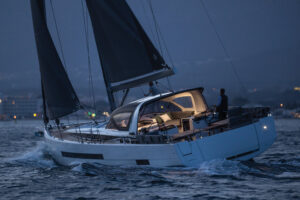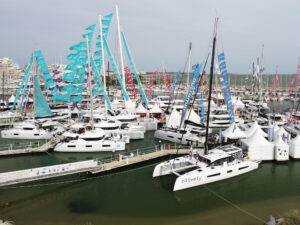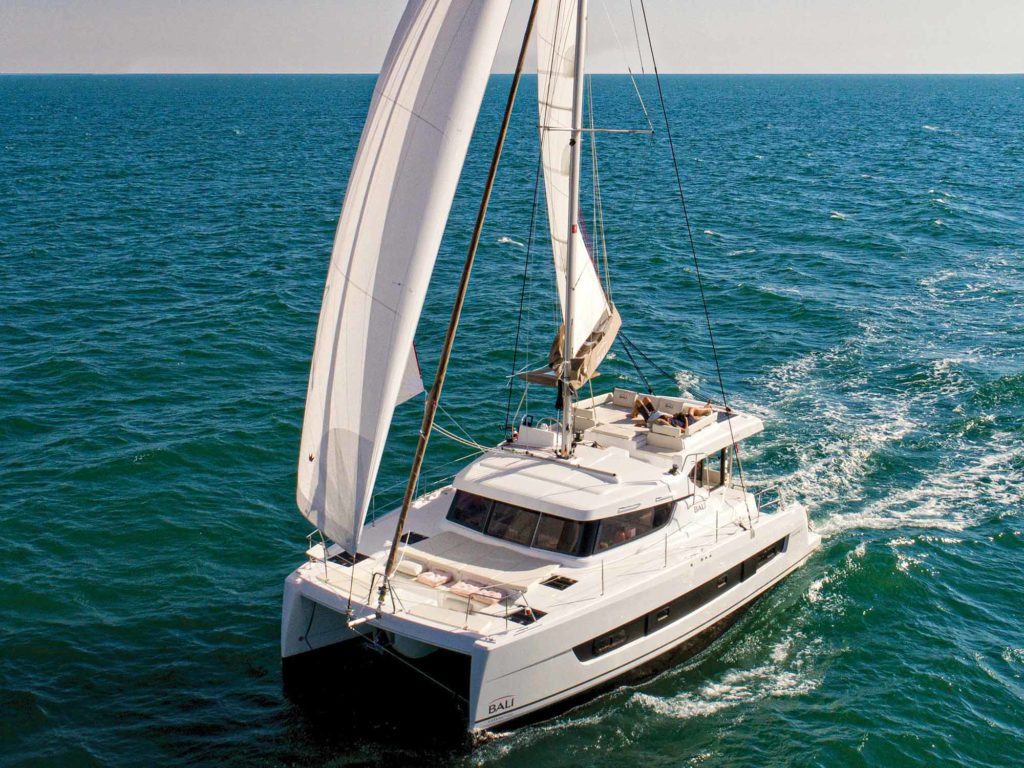
Monohull or catamaran? Three cabins or five? Two heads or four? Flybridge or raised helm? Comfort or price? Just as there’s no one perfect charter destination, it’s impossible to say what the best boat is for a sailing vacation. For those who hate making decisions, that’s the bad news. But for those who like options, the good news is you have a lot of choices as you plan how to make your escape.
To get an idea of what constitutes a good charter boat, I reached out to 10 of the largest production boatbuilders and asked which current model is most often sold to charter fleets around the world. Not surprisingly, all but one of those popular charter boats are in the mid-40-foot range, and available with three to four—and in a couple of instances, five or even six—cabins.
Why 40-something feet? Boats in that size range are big enough to accommodate multiple couples or large families but are manageable for an average sailor who may or may not have experienced crew to help with boat handling. Expense is a factor too. The bigger the boat, the more it’s going to cost to rent, but the number of cabins (and ability to split costs among guests) might not increase accordingly. And, bigger boats are more challenging to handle, which means unless you own a 50-something footer, or have chartered a boat previously in that size range, you might face the added expense of having to hire a captain, at the outset of the trip at least.
Franck Bauguil is vice president of yacht ownership and product development for the Moorings and Sunsail. Both brands are owned by Travelopia, which buys essentially all of its catamarans from Robertson & Caine in South Africa. Travelopia is, in turn, R&C’s only customer, so all of the cats it builds are optimized for charter by Bauguil and designers at Simonis Voogd Design (privately owned R&C cats are sold under Travelopia’s Leopard brand).
When it comes to monohulls, though, both the Moorings and Sunsail buy select models from Beneteau and Jeanneau. For bases in the Mediterranean, monohulls tend to dominate the fleets, partly because of sailing preferences and partly because in crowded harbors, there isn’t room to tie big cats stern to at the quay. For those fleets, Bauguil says he prefers boats that have as many cabins as possible because Europeans tend to squeeze as many aboard as possible to reduce costs. That means four cabins and two heads are ideal in the mid-40-foot range.
Across the Caribbean, where North American customers tend to flock, he leans toward a mix of boats, including layouts with three cabins and two heads. Americans, he says, are more concerned about comfort and amenities.
Sailing conditions also factor in. At bases where the trade winds tend to blow harder and passages between islands are longer and more exposed, such as in St. Lucia and the Windward Islands, larger monohulls (and cats) dominate.
Other charter companies have more-diverse fleets. The Catamaran Company, for instance, offers a number of different brands of cats at its base in Tortola, in the British Virgin Islands. Owner Hugh Murray says different customers come looking for boats with a variety of features. One of his workhorses is the Lagoon 450. Customers like the flybridge for entertaining and relaxing, and with four guest cabins, plus two more bunks in the forepeaks, the 450 can accommodate up to 10 guests.
Others prefer the Fountaine Pajot catamarans that he manages in his fleet. Charterers like the raised helm, so a skipper can communicate with people sitting in the lounge atop the Bimini, or in the cockpit below.
“Then you have Bali, which takes the saloon and puts it in the cockpit; it’s like a cabana,” Murray says of that brand’s open, airy layout.
Cindy Kalow, owner of Superior Charters in Bayfield, Wisconsin, also manages a diverse fleet of older and newer boats, including a couple of Lagoon catamarans. Alongside her 30-boat charter fleet, she also runs a sailing school, and is the area’s Jeanneau and Lagoon dealer.
When customers ask her what’s the best boat to buy to put into charter, she tells them, “It’s the boat that makes you happy when you walk down the dock.”
People plan out a sailing vacation for any number of reasons. For some, it’s the destination; for others, it’s a chance to sail in a regatta in a tropical location; or a new-boat shopper might want to try out a particular model for a week or two before they buy. Chances are, if you have a particular kind, brand or model of boat you’re interested in, if you shop around, you’re bound to find it for charter.
What follows is a brief look at those 10 bestsellers mentioned in the beginning.
Bali Catspace Sail
Several years ago, longtime French performance-catamaran builder Chantier Catana jumped into the charter game with its Bali line of fixed-keel, roomy cruising cats. The most recent addition to that lineup, and reportedly the boat most often chosen when charter companies go shopping, is the 40-foot Bali Catspace Sail (a motor version is also available).
Like its larger siblings, the Catspace has a range of features designed for a crew of friends headed for tropical climes looking for sun, fun and rum, all mixed with a healthy dose of trade-wind sailing.
Designed by Olivier Poncin, the Catspace sports the Bali trademark garage-style saloon door that slides up and out of the way, opening up the cockpit and interior into one large, shaded living and entertaining space. A helm station is located one floor up, along with a padded lounge area that shares a portion of the cabin top aft of the mast and the cockpit Bimini.
Forward of the cabin, instead of trampolines, a solid fiberglass bridge deck spans the hulls to make room for yet another cushioned area in which to hang out. An added bonus of the solid foredeck is the lack of spray when underway.
Under sail, a self-tacking jib keeps the work simple for the day’s designated skipper, meaning the rest of the crew can kick back and enjoy the ride.
Depending on the charter program, the boat may be available in either a three- or four-cabin layout, and equipped with a range of kit that includes electric winches, a sprit and off-wind sail, watermaker, microwave, and an impressively sized fridge and freezer.
Bavaria C45
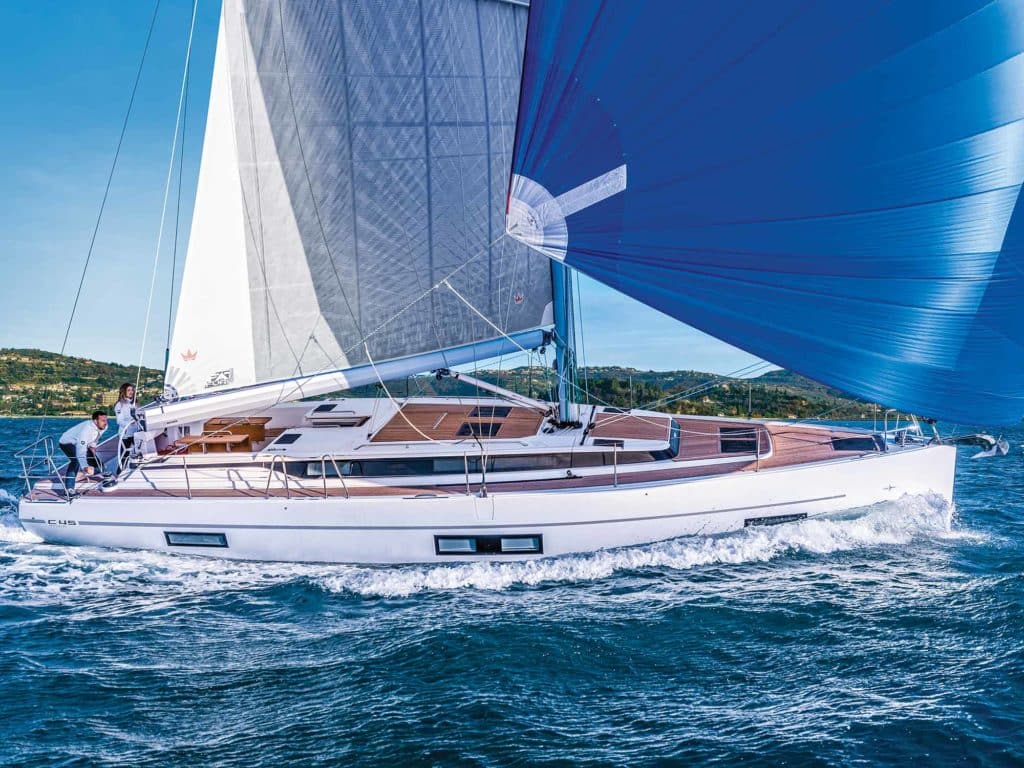
Charterers bound for vacations aboard a monohull in Europe and certain parts of the Caribbean are likely to encounter the latest generation of Bavaria Yachts, which are built in Germany and drawn and styled by the team at Cossutti Yacht design in Italy.
I got to visit one of the latest models, the C45, at its introduction during the 2018 boat show in Dusseldorf, and my immediate impression was that it would make a good home away from home with a few family members and friends. I’ve not yet had a chance to sail the 45-footer, but I have thoroughly enjoyed a couple of afternoons out on the water aboard two other Cossutti-designed Bavarias. Both boats could click off the miles, and both were quite easy to sail shorthanded, thanks to a self-tacking jib and a double-ended mainsheet led to each of the twin wheels.
The cockpit area forward of the helms on the C45 includes benches to either side, each with its own table. This arrangement creates a clear path to the companionway and saloon down below.
At anchor, a large fold-down swim platform provides access to both the water and a dinghy garage. The transom is also home to a sink and grill for outdoor cooking.
Thanks to hull chines that create considerable interior volume, depending on your crew’s needs, the C45 is available with three, four and five cabins, so you can bring along the whole gang.
Beneteau 46.1
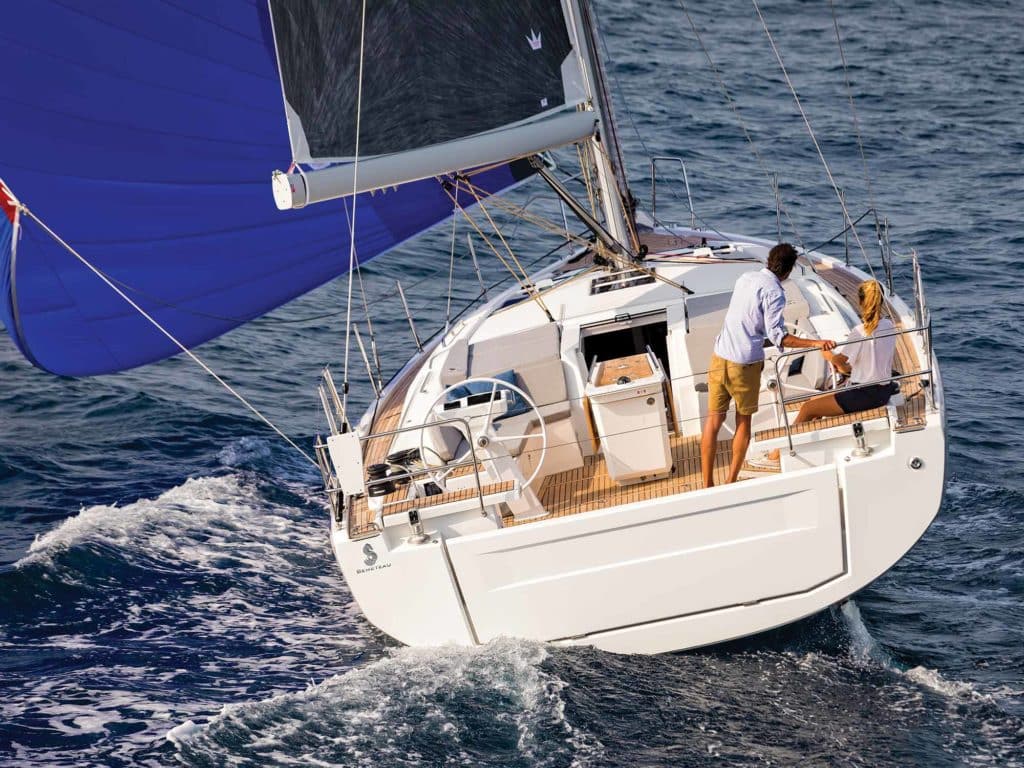
Beneteau first introduced the Oceanis 46.1 to North American sailors during the 2018 fall boat season, and it’s no surprise that it’s now the French builder’s most popular model sold to charter companies, especially in Europe, where monohulls remain in demand thanks to crowded harbors and the preference for tying stern to along a packed quay in many locations.
I got aboard the boat a couple of times that year, once in a new-model preview in Newport, Rhode Island, and again with CW’s Boat of the Year judges in Annapolis, Maryland. Both times I came away impressed by the boat’s performance and creature comforts.
The Pascal Conq-designed hull is slippery through the water and delivers lots of space below (more on that in a minute). In 10 knots of breeze, we cruised upwind at close to 8 knots flying the easy-to-handle 107 percent genoa; cracked off on a reef with the code zero unfurled, the speedo jumped well into the 9s.
Meanwhile, the deck layout and interior by Nauta were both conducive to chartering. The work of sailing takes place aft of the twin helms, where sheets and other control lines are close at hand for the skipper and crew who want to join the fun. Those who want to relax can enjoy cockpit seats that convert to sunbeds, with more lounge pads to either side of the companionway.
The 46.1 comes in layouts ranging from three cabins and two heads to five cabins, meaning you can escape for a romantic week as a couple, or bring along a crowd for a party.
Dufour 530 Grand Large
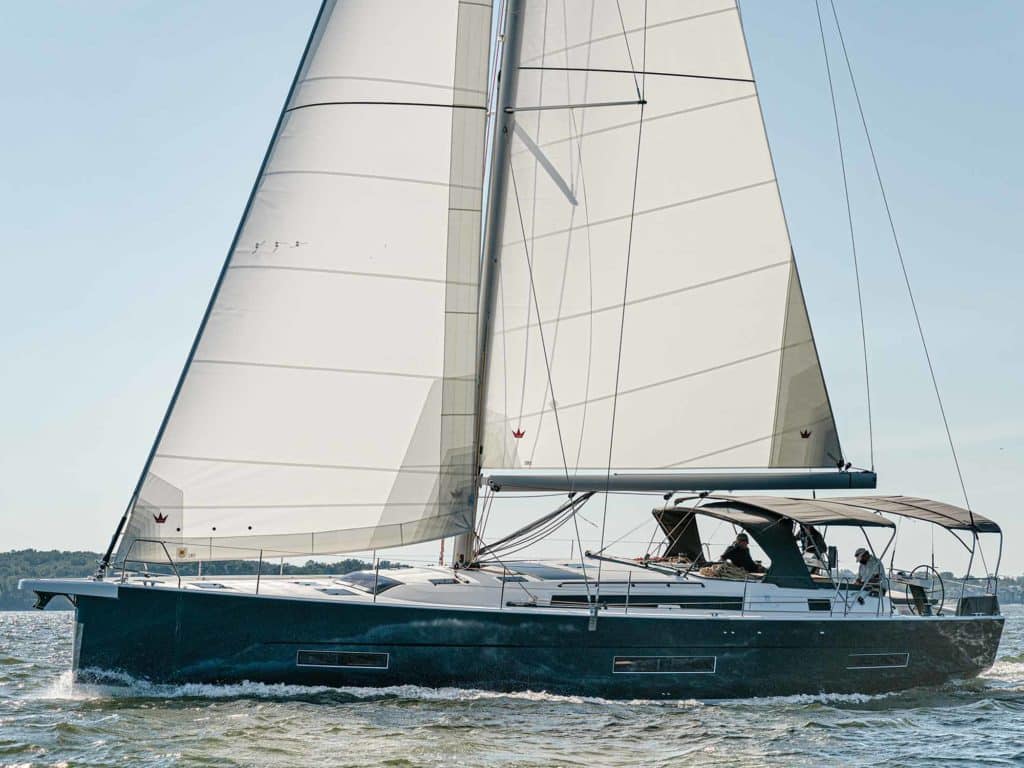
It’s easy to understand why the recently introduced Dufour 530 is already the company’s top seller for chartering. It’s a big, comfortable boat, loaded with options, and boy, does it sail.
For more than 15 years, Dufours have been designed by Umberto Felci, of Felci Yacht Design. The result is a range of boats which, as it scales up in size, maintains the same look and feel among all the models. With many charter fleets comprised of various-size Dufours, return skippers can feel encouraged to push their skill set by moving up from, say, the mid-40-footer they rented last time, and opting instead to step over the 50-foot threshold. And when they do, they will find that the 530′s self-tacking jib or slightly overlapping genoa is relatively easy to handle, while the rest of the boat has a familiar feel, right down to the layout of the saloon with its galley forward by the mast, and the grill and fold-down swim platform on the stern.
With a little more than 16 feet of beam, there’s lots of room for guests and belongings down below. Depending on the layout offered by the charter company, there can be anywhere from three to six cabins.
When sailing, that beamy hard-chined hull tends to keep the boat standing upright, ensuring nonsailing guests a comfortable ride. But the sailors aboard won’t be disappointed either. On a test sail this past fall, loping along at 8 knots in 10 knots of breeze, even though the Boat of the Year team was working, we thoroughly enjoyed ourselves.
Fountaine Pajot Isla 40
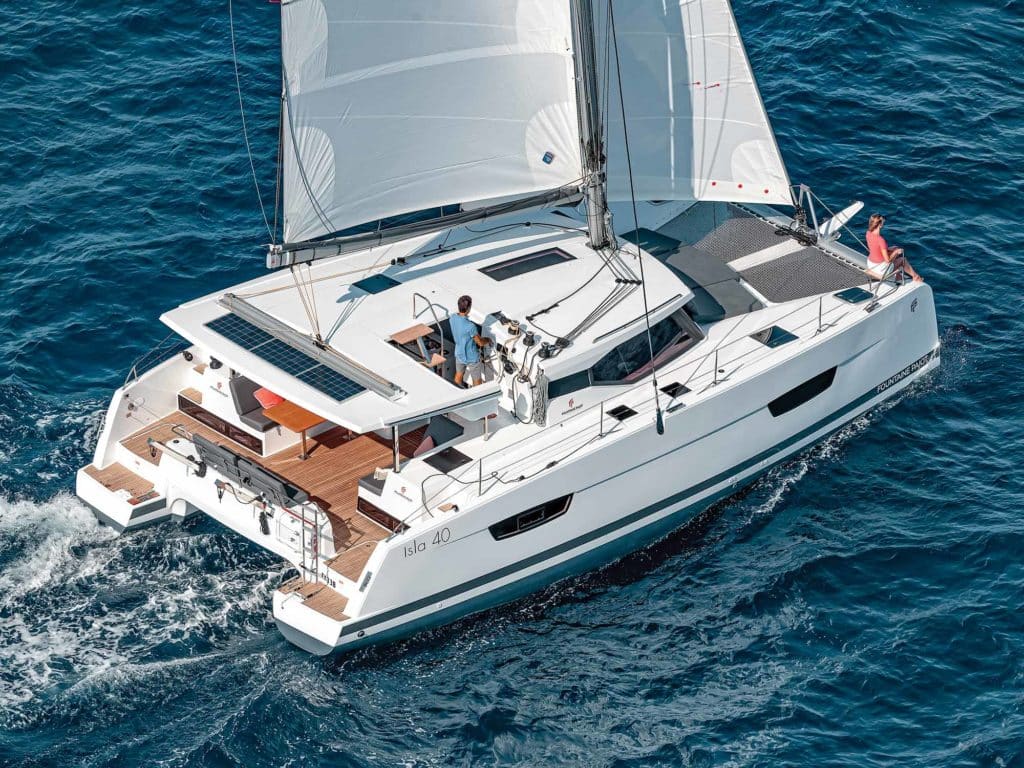
Fountaine Pajot has packed a lot of versatility into the Berret-Racoupeau-designed Isla 40, the smallest boat in the builder’s seven-model range of cruising catamarans.
At 40 feet LOA, the Isla is available in both a three- and four-cabin layout, depending on the charter program, and can include crew quarters in the bows, making it also suitable for a crewed charter.
The size of the cat, its sailing ability and its creature comforts are no doubt the reasons for its appeal to charterers. Laid out with four cabins with en suite heads, the Isla can carry a crowd, but its size also makes it easily handled by a skipper and shorthanded crew, or even a couple off on a holiday.
The Isla’s helm station is located on the starboard bulkhead, and it’s accessible from both the cockpit below and the side deck. This keeps the driver in contact with those lounging under the Bimini, but it also provides excellent access forward, if needed. All sail control lines are led to winches close at hand on the cabin top.
A well-equipped galley is just inside the saloon door, so meals can easily be passed to guests seated at the large outdoor table. Inside, a U-shaped couch forward surrounds a second, smaller table. Large windows surround the cabin, providing excellent 360-degree views. Meanwhile, ports in either hull allow light to pour into the sleeping cabins below. All in all, the Isla offers big-cat luxury at a smaller-boat price.
Hanse 458
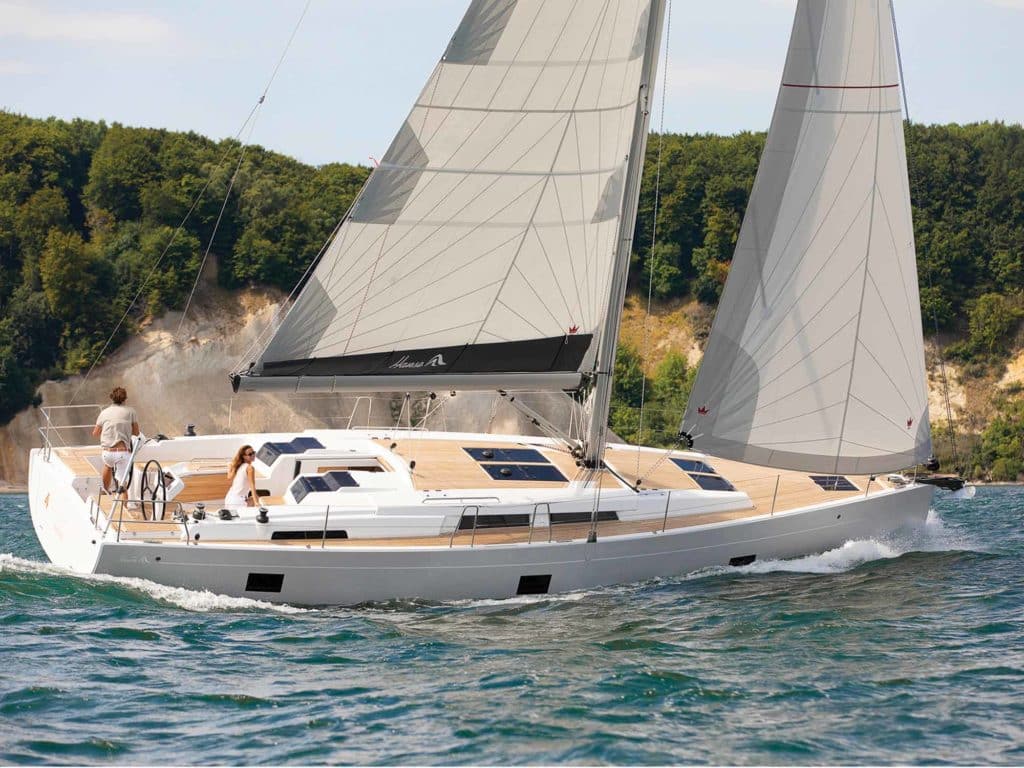
If your sailing vacation plans include a Caribbean or European destination, a Hanse 458 could very well be one of the monohull sailboats available in the bareboat fleet. Designed by Judel/Vrolijk and built in Germany, the 458 is available with either three or four cabins, the latter likely being the preferred layout for the charter crowd.
As with its larger and smaller siblings, the 458 features a self-tacking jib, which simplifies maneuvering under sail. Tacking requires just a turn of the wheel, while a double-ended German-style mainsheet, led to a winch at each wheel, means that you have control of the main at all times, especially when jibing. Simple sailing doesn’t mean a lack of performance though. Hanse hulls are slippery, and the boat comes standard with a full-batten main that keeps the 458 moving well in light air. The main is easily put away in a boom pouch at the end of the day.
All the sailing is done aft of the twin wheels. Forward of them, guests can enjoy the generously sized L-shaped cockpit seats that sit to either side of a large table, complete with a built-in cooler. At anchor, a large swim platform provides easy access to the water, dinghy or, if Med-moored, the quay. And a clean uncluttered deck means there’s plenty of space to sunbathe forward of the mast.
Down below, the 458 is open and airy, with a minimalist interior that includes a well-stocked galley and a spacious dining area in the saloon.
Jeanneau Sun Odyssey 440
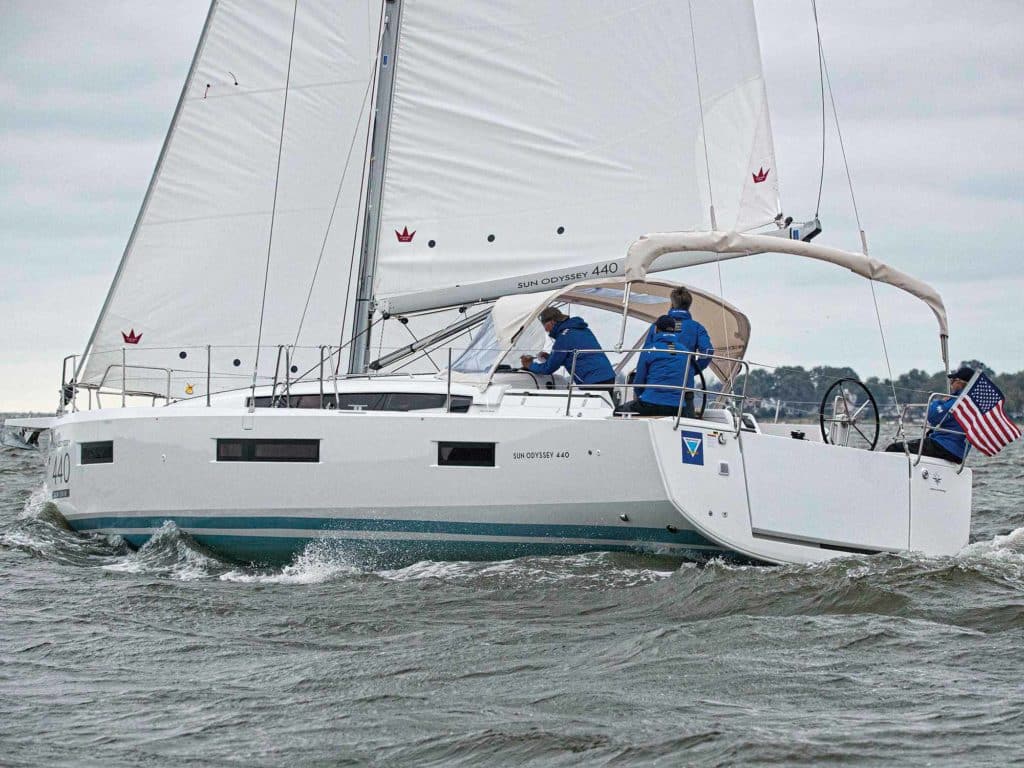
Sometimes a charter trip means you get to discover a new location; other times, it’s a chance to experience a whole new concept in boat design. Depending on your destination, the Jeanneau Sun Odyssey 440 is capable of delivering on both counts.
With the 440, Jeanneau, along with designers Phillippe Briand and Jean-Marc Piaton, introduced the proprietary Walk Around Decks concept, an idea that garnered multiple awards, including CW’s Most Innovative prize in the 2018 Boat of the Year contest.
With hard chines and beam carried well aft, the builder was able to reallocate interior space to include two full-size aft cabins and, topsides, side decks that slope down to meet the cockpit floor. From either of the twin wheels, captain and crew need only step outboard and saunter forward rather than having to climb over cockpit coamings to reach the side decks.
At anchor, the aforementioned cockpit coamings are hinged and can be folded out to create two huge sunbathing beds for the crew. Down below, meanwhile, layouts include a three-cabin version, with a large berth forward, or two forward cabins, both with double berths.
Under sail, the 440 performs well. The hull is slippery, and the anchor roller doubles as a tack-down point if off-wind sails are available; twin rudders provide plenty of control as conditions get sporty. In port, the roomy interior is bright and well-equipped for relaxing and entertaining around a large dining table surrounded by a U-shaped couch and centerline bench.
Lagoon 42
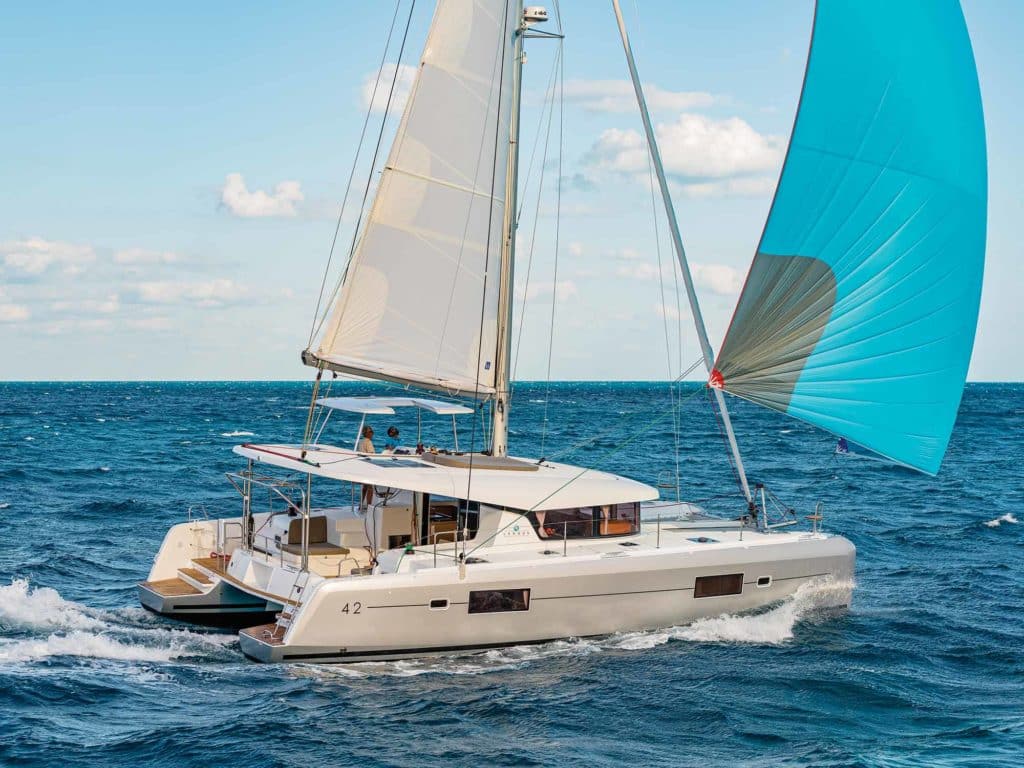
Various models of Lagoon Catamarans are found in charter fleets around the world, but the company says that the Lagoon 42, launched in 2016 and named Best Full-Size Catamaran Under 50 Feet in CW’s 2017 Boat of the Year contest, is the top-selling model, probably for a number of reasons.
First, the boat’s price and size make it an affordable option for vacationers because they can take along as many guests as they might on a larger, more expensive model. As with most cats in this size range, the 42 is available in either a three- or four-cabin layout. In either case, ports in the hull let lots of light into the cabins, and opening hatches provide good ventilation.
And then there is the sail plan. Lagoon and the designers at VPLP have in recent years favored masts set farther aft, with high-aspect mainsails and larger headsails, which on the 42 includes a self-tacking jib and, if supplied by the charter company, a code zero or other off-wind sail.
On a sailing vacation, often the crew includes kids or friends with varying degrees of sailing experience. At 42 feet, this model is still relatively easy for a skipper to handle, even if everyone else decides to kick back and enjoy the ride. The helm is semiraised, so a driver sits looking out over the cabin top ahead and the Bimini behind. This provides good sightlines and also keeps the skipper in touch with the crew. All sail control lines, meanwhile, are led to clutches and a pair of winches within arm’s reach of the wheel, which is right where they should be.
Moorings 4500/Sunsail 454
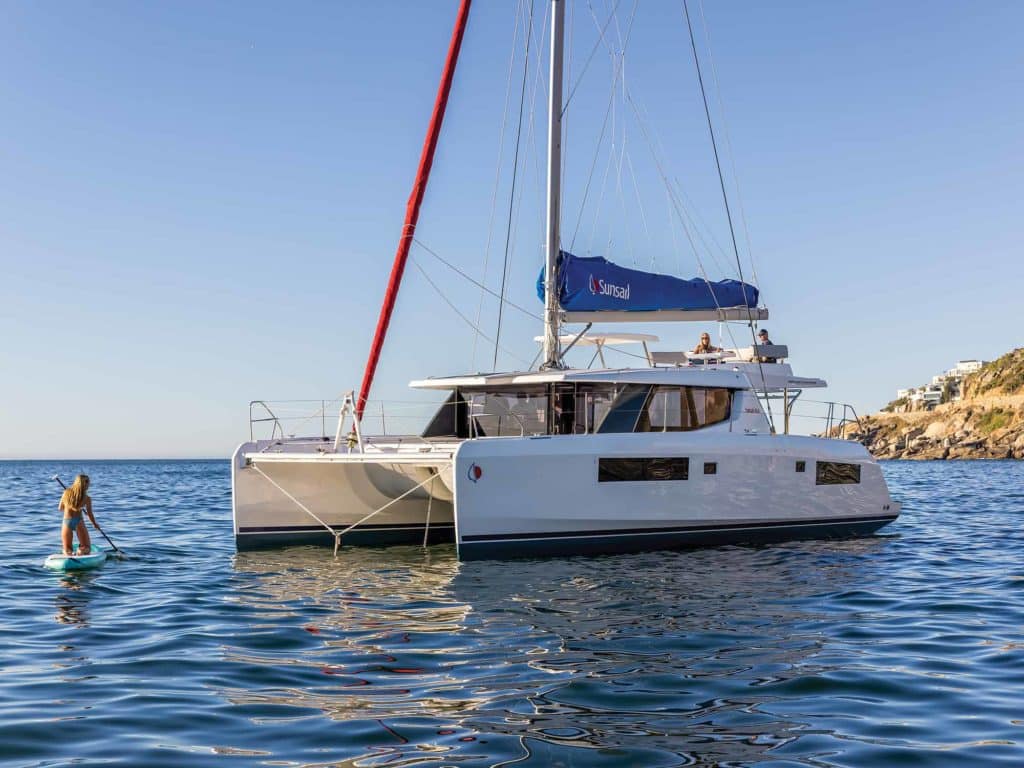
Owned by the same parent company, the Moorings and Sunsail spec out and buy more charter catamarans than anyone in the world, and with the feedback that they get from customers, they have a pretty good idea of what people are looking for in a sailing vacation. So, there’s little wonder that the 45-footer built by Robinson and Caine and sold into charter as the Moorings 4500 and Sunsail 454 won the title of Best Charter Catamaran when CW’s Boat of the Year judges were handing out awards in 2017.
The popular midsize cat is also sold to private owners as the Leopard 45, and is available in either a three- or four-cabin layout. Both charter brands opt for the latter, which provides for accommodations for up to 11 guests, thanks to a bunk forward of the double cabins in the port hull and a convertible berth for two in the saloon.
As with other models designed by Alex Simonis, the 45-footer features noteworthy views from multiple ports and cabin windows, as well as a watertight door that opens onto a forward, shaded cockpit. Anchored in the trade winds with both saloon doors open, the breeze keeps things cool, and sunrises and sunsets can be enjoyed while sitting at either end of the boat.
Underway, a square-top main and overlapping genoa provide plenty of horsepower, and there are multiple places on board for couple to find a private place to sit, or for the crew to gather to enjoy the ride.
Nautitech 46 Fly
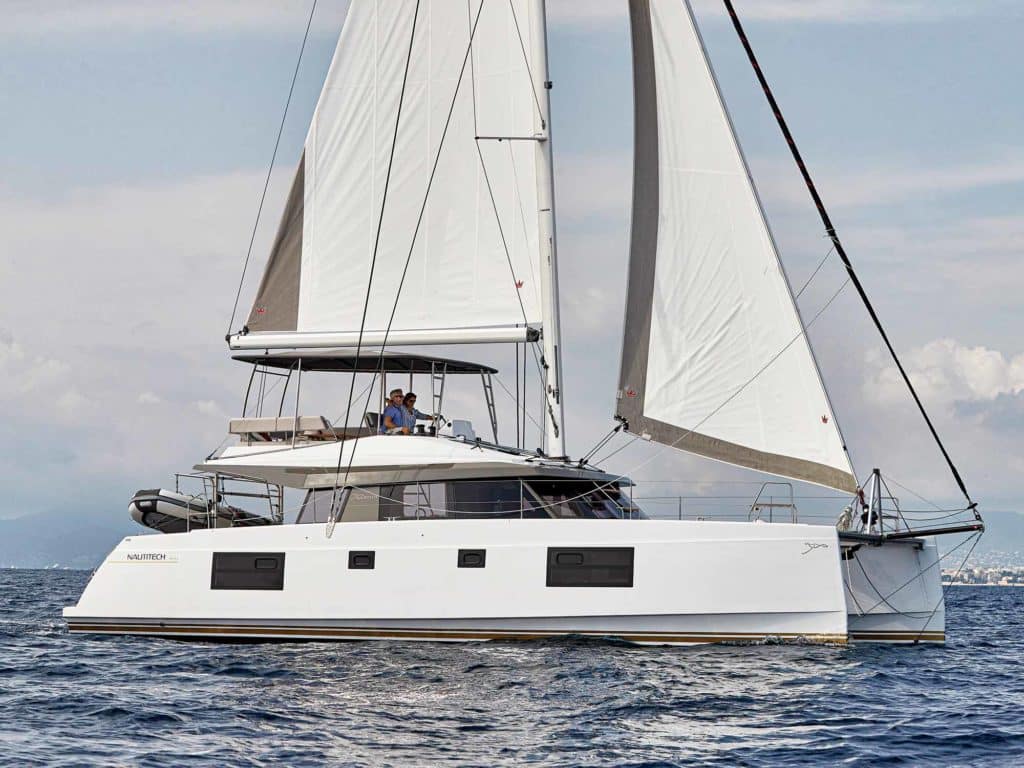
Who doesn’t appreciate a rooftop balcony with a view, especially if that panorama consists of white sand beaches, palm trees waving in the trade winds, and gin-clear deep blue waters? Well, that’s exactly what you’ll get if you’re spending a week or two aboard a charter cat whose design includes a flybridge, say, for instance, the Nautitech 46 Fly.
Designed by Marc Lombard, the 46 comes in an open version, with the helm mounted on the cabin bulkhead, and the Fly, with essentially a third floor added atop the saloon and cockpit Bimini. From there, the skipper has a commanding 360-degree view while seated at the helm, and the crew can lounge around a table surrounded by padded seats and a sun lounge.
In other words, the flybridge adds the option of sailing and living completely alfresco if guests prefer to, or they can relax in the shade down below under the Bimini. And should a squall come through and rain on paradise, there’s the adjacent saloon with its aft-facing galley and additional couches to enjoy.
For charter, the 46 Fly comes in a four-cabin layout with en suite heads. A self-tacking jib and full-batten main are standard. Depending on the charter company, the sail inventory also might include a code zero or other off-wind sail. Atop the flybridge, all sail control lines lead to the winches at the centerline helm, making shorthanded sailing quite possible if others aboard want to simply sit and enjoy the ride.
Mark Pillsbury is CW’s editor.

